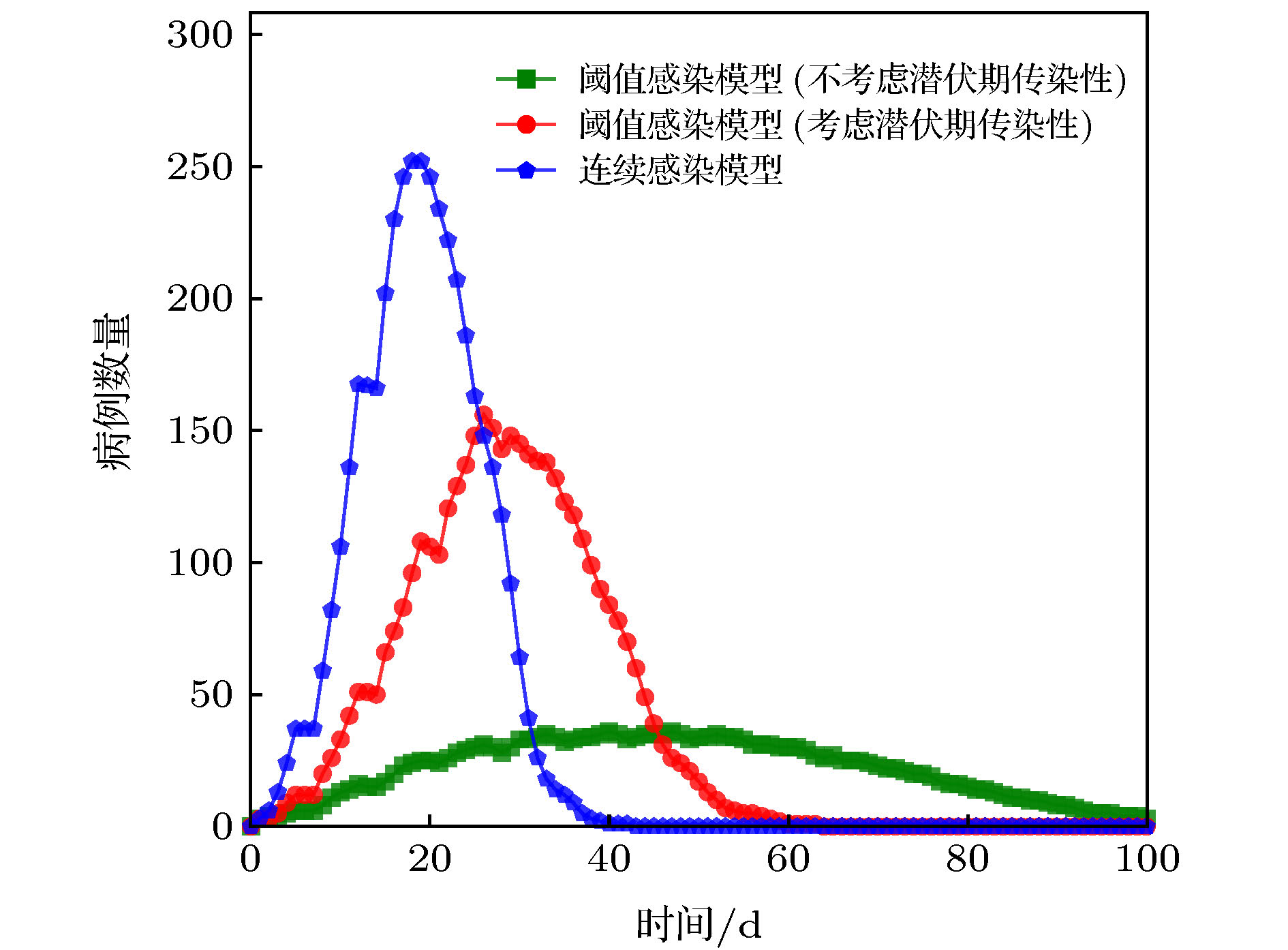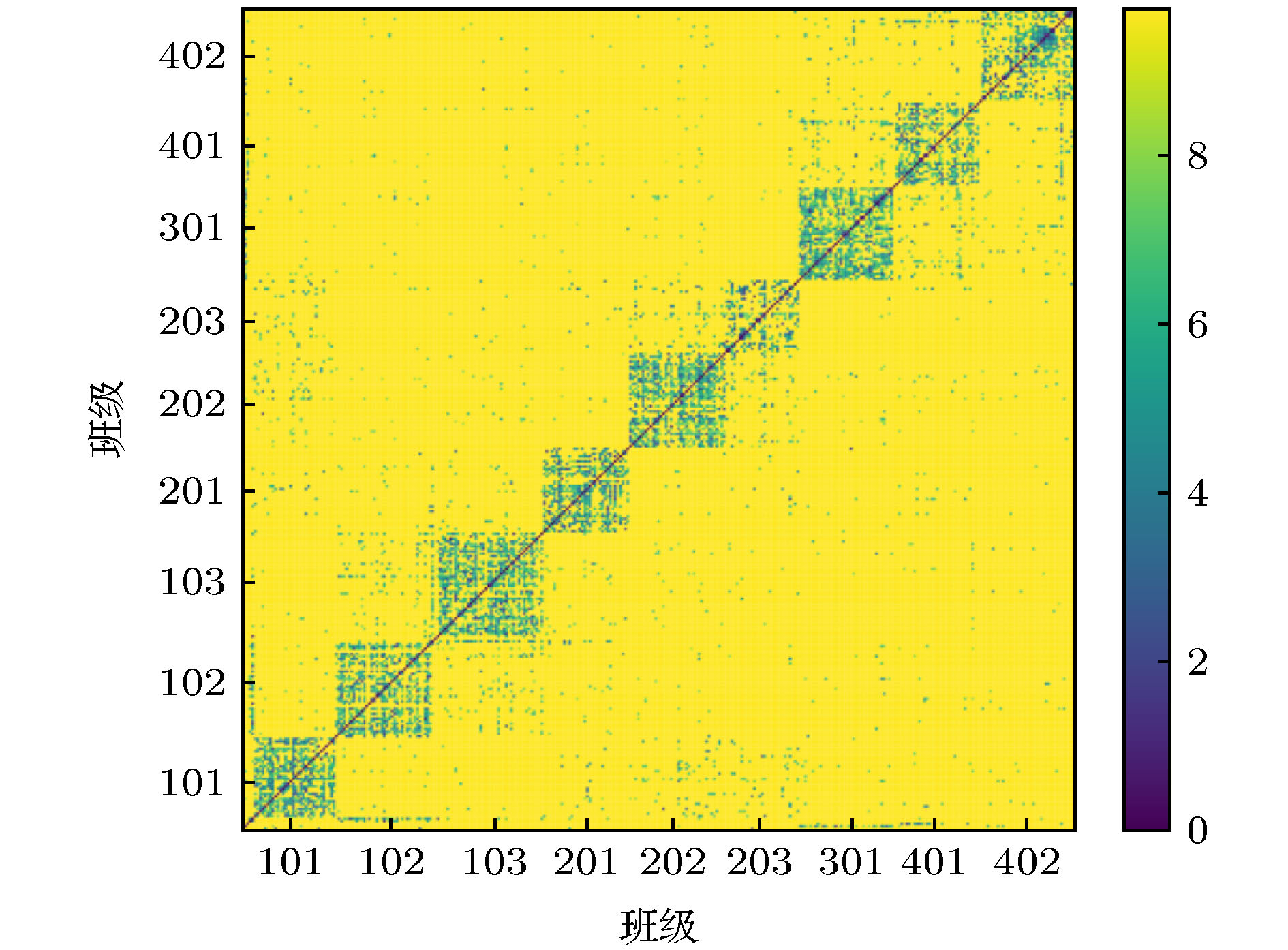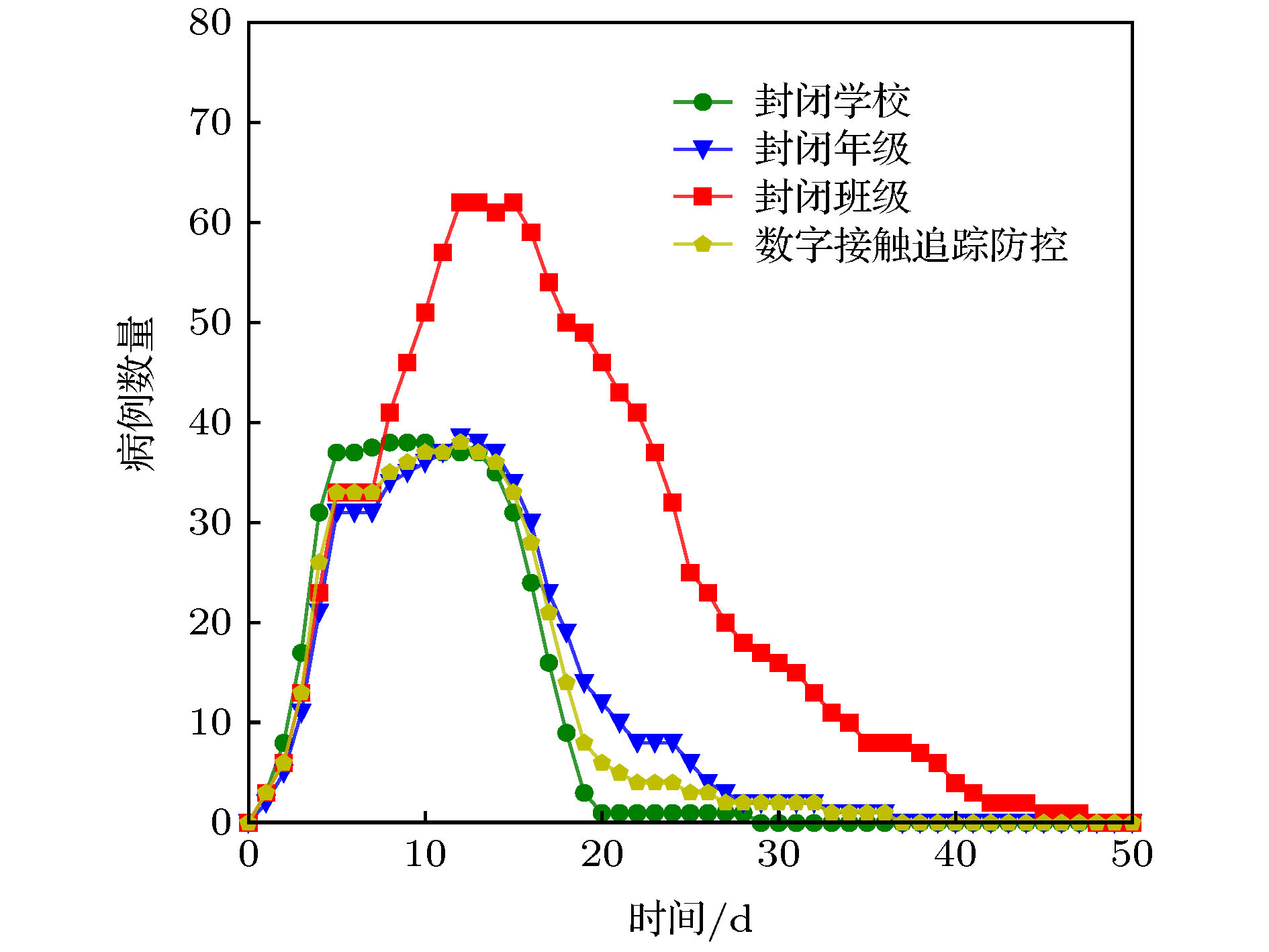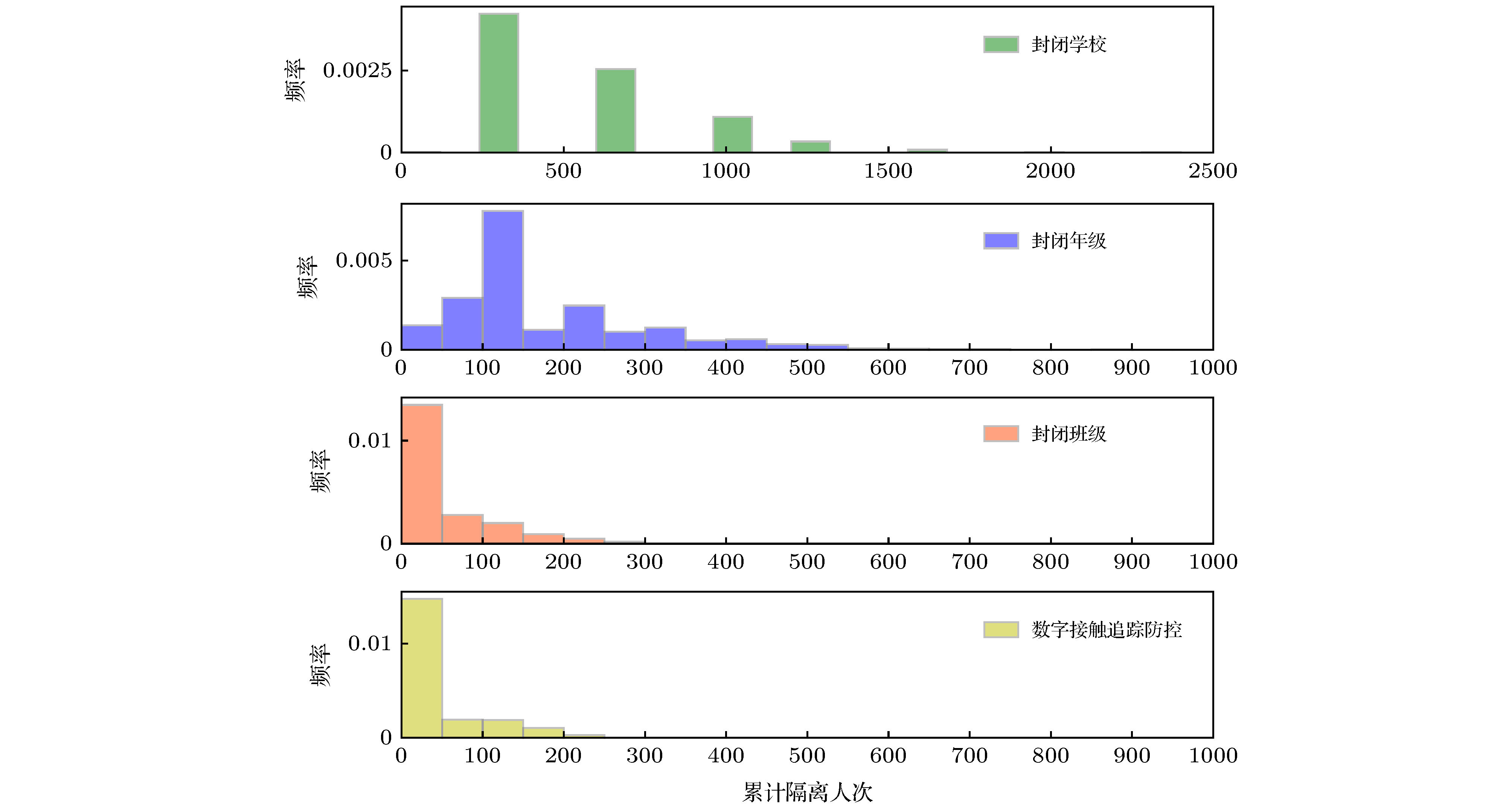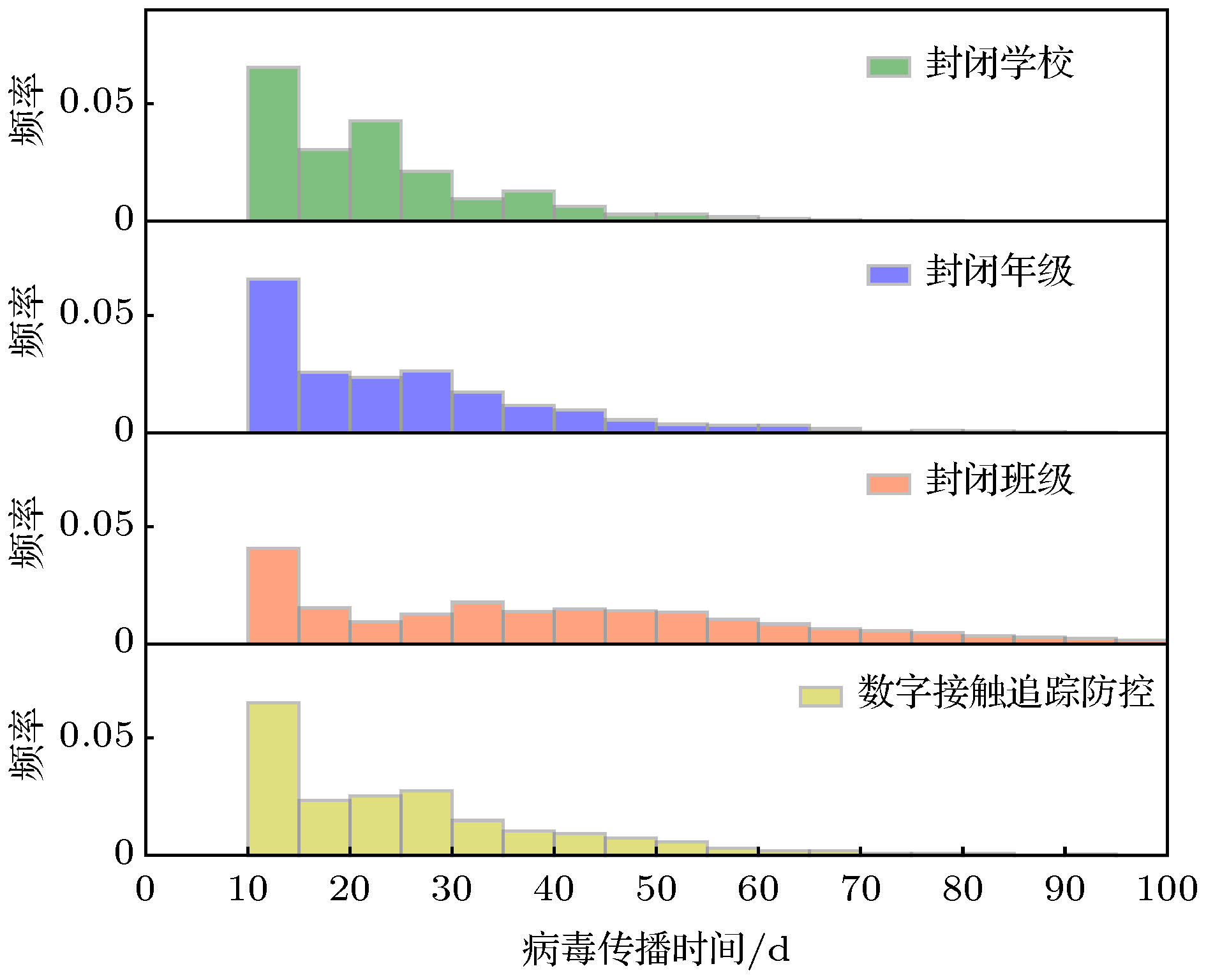-
新冠肺炎疫情在中国平稳后多省已开始复学, 在学校这种封闭式环境中师生长时间接触会增加疫情爆发的可能. 虽然学校停课可以有效地缓解疫情, 但大面积的学生隔离会造成人群恐慌和社会负担, 所以针对校园这一特殊环境需要制定更加科学的防控措施. 本文中根据患病期间新冠肺炎感染个体病毒排出情况重新定义患者的传染能力, 将其引入到传统易感-潜伏-传染-恢复(SEIR)模型后提出了更符合新冠肺炎患者实际传播的连续感染模型. 其次, 通过真实接触数据计算学生间有效距离, 提出针对校园的数字接触追踪防控措施. 通过真实在校期间学生接触数据与连续感染模型模拟新冠肺炎在校园中的传播, 从而比较各种防控措施对校园疫情的防控效果, 并且通过施加防控措施时累计隔离人次评估各防控措施带来的社会影响. 结果发现, 相比于传统SEIR模型, 新冠肺炎在连续感染模型中会造成更大的病例规模, 在连续感染模型中验证的防控措施更具有说服力. 在校园内采取数字接触追踪防控会在控制隔离人次最少的情况下达到与封闭学校近似的效果. 本文研究有助于学校选取合适的防控措施, 提出的连续感染模型有助于研究人员更准确地仿真新冠肺炎传播.
-
关键词:
- 新冠肺炎 /
- 聚集性疫情 /
- 疾病传播 /
- 易感-潜伏-传染-恢复模型
After the COVID-19 epidemic leveled off in China, many provinces have started to resume schooling. Long-term contact between students and teachers in such a closed environment in schooling can increase the possibility of the outbreak. Although the school closure can effectively alleviate the epidemic, large-scale students’ isolation not only causes social panic but also brings huge social and economic burden, so before the emergence of school epidemics, one should select and adopt more scientific prevention and control measures. In this study, according to the virus excretion of COVID-19 patients in the disease period, the infectious capacity of patients is redefined. After introducing it into the traditional suspected-exposed-infected-removed (SEIR) model, a continuous infection model that is more consistent with the actual transmission of COVID-19 patients is proposed. Secondly, the effective distance between students is calculated through real contact data. Based on the analysis of the effective distance, three types of isolation area prevention and control measures are proposed and compared with the recently proposed digital contact tracking prevention and control measures. Simulating the spread of COVID-19 in schools through real student contact data and continuous infection models, in order to compare the preventions and control effects of various prevention and control measures in the school epidemic situation, and evaluating the social influence of measures by accumulating the number of quarantines when prevention and control measures are adopted, we find that the COVID-19 can lead the cases to happen on a larger scale in the continuous infection model than in the traditional SEIR model, and the prevention and control measures verified in the continuous infection model are more convincing. Using digital contact tracking prevention and control measures in schools can achieve similar results to those in closed schools with the smallest number of quarantines. The research in this paper can help schools choose appropriate prevention and control measures, and the proposed continuous infection model can help researchers more accurately simulate the spread of COVID-19.[1] 陈端兵, 白薇, 王岩, 王敏, 俞伍平, 周涛 2020 电子科技大学学报 49 339
 Google Scholar
Google Scholar
Chen D B, Bai W, Wang Y, Wang M, Yu W P, Zhou T 2020 J. Univ. Electron. Sci. Technol. Chin. 49 339
 Google Scholar
Google Scholar
[2] Viboud C, Boëlle P Y, Cauchemez S, Lavenu A, Valleron A J, Flahault A, Carrat F 2004 Br. J. Gen. Pract. 1263 291
[3] 孙皓宸, 徐铭达, 许小可 2020 电子科技大学学报 49 399
 Google Scholar
Google Scholar
Sun H C, Xu M D, Xu X K 2020 J. Univ. Electron. Sci. Technol. Chin. 49 399
 Google Scholar
Google Scholar
[4] Rockx B, Kuiken T, Herfst S, Bestebroer T, Lamers M M, Oude Munnink B B, Meulder D, Amerongen G, Brand J, Okba N M A, Schipper D, Run P, Leijten L, Sikkema R, Verschoor E, Verstrepen B, Bogers W, Langermans J, Drosten C, Vlissingen M, Fouchier R, Swart R, Koopmans M, Haagmans B L 2020 Science 368 1012
 Google Scholar
Google Scholar
[5] Cauchemez S, Ferguson N M, Wachtel C, Tegnell A, Saour G, Duncan B, Nicoll A 2009 Lancet Infect. Dis. 9 473
 Google Scholar
Google Scholar
[6] Litvinova M, Liu Q H, Kulikov E S, Ajelli M 2019 Proc. Natl. Acad. Sci. U.S.A. 116 13174
 Google Scholar
Google Scholar
[7] Brown S T, Tai J H Y, Bailey R R, Cooley P C, Wheaton W D, Potter M A, Voorhees R E, LeJeune M, Grefenstette J J, Burke D S, McGlone S M, Lee B Y 2011 BMC Public Health 11 353
 Google Scholar
Google Scholar
[8] Ferretti L, Wymant C, Kendall K, Zhao L, Nurtay A, Abeler-Dörner L, Parker M, Bonsall D, Fraser C 2020 Science 368 eabb6936
 Google Scholar
Google Scholar
[9] Wang R, Chen F L, Chen Z Y, Li T X, Harari G, Tignor S, Zhou X, Ben-Zeev D, Campbell, Andrew T 2014 Proceedings of the 2014 ACM International Joint Conference on Pervasive and Ubiquitous Computing New York, USA, September 13–17, 2014 p3
[10] Zhou M Y, Ma M H, Zhang Y K, SuiA K, Pei D, Moscibroda T 2016 Proceedings of the 2016 ACM International Joint Conference on Pervasive and Ubiquitous Computing New York, USA, September 12–16, 2016 p316
[11] Cao Y, Gao J, Lian D F, Rong Z H, Ro ng, Shi J T, Wang Q, Wu Y F, Yao H X, Zhou T 2018 J. R. Soc. Interface 15 DOI: 10.1098/rsif.2018.0210
[12] Yao H X, Lian D F, Cao Y, Wu Y F, Zhou T 2019 ACM Trans. Intell. Syst. Technol. 10 1
[13] The SocioPatterns collaboration http://www.sociopatterns.org/[2020-6-11]
[14] Rossana M, Julie F, Alain B 2015 PLoS One 10 e0136497
 Google Scholar
Google Scholar
[15] Cattuto C, Broeck W V D, Barrat A, Colizza V, Pinton J F, Vespignani A 2010 PLoS One 5 e11596
 Google Scholar
Google Scholar
[16] 李靖, 李聪, 李翔 2019 复杂系统与复杂性科学 16 1
 Google Scholar
Google Scholar
Li J, Li C, Li X 2019 Complex Syst. Complexity Sci. 16 1
 Google Scholar
Google Scholar
[17] 梁迪, 崔靖, 李翔 2018 计算机学报 41 1598
 Google Scholar
Google Scholar
Liang D, Cui J, Li X 2018 Chin. J. Comput. 41 1598
 Google Scholar
Google Scholar
[18] Gemmetto V, Barrat A, Cattuto C 2014 BMC Infect. Dis. 14 695
 Google Scholar
Google Scholar
[19] 范如国, 王奕博, 罗明, 张应青, 朱超平 2020 电子科技大学学报 49 369
 Google Scholar
Google Scholar
Fan R G, Wang Y B, Luo M, Zhang Y Q, Zhu C P 2020 J. Univ. Electron. Sci. Technol. Chin. 49 369
 Google Scholar
Google Scholar
[20] Anderson R M, Anderson B, May R M 1993 Immunology Today (London: Oxford Ford University Press) p616
[21] Guan W J, Ni Z Y, Hu Y, Liang W H, Ou C Q, He J X, Liu L, Shan H, Lei C L, Hui D, Du B, Li L J, Zeng G, Yuen K Y, Chen R, Tang C L, Wang T, Chen P Y, Xiang J, Li S Y, Wang J L, Liang Z J, Peng Y X, Wei L, Liu Y, Hu Y H, Peng P, Wang J M, Liu J Y, Chen Z, Li G, Zheng Z J, Qiu S Q, Luo J, Ye C J, Zhu S Y, Zhong N S 2020 N. Engl. J. Med. 382 1708
 Google Scholar
Google Scholar
[22] Wang D W, Hu B, Hu C, Zhu F F, Liu X, Zhang J, Wang B B, Xiang H, Cheng Z S, Xiong Y, Zhao Y, Li Y, Wang X H, Peng Z Y 2020 JAMA-J. Am. Med. Assoc. 323 1061
 Google Scholar
Google Scholar
[23] 孙琬琬, 凌锋, 潘金仁, 蔡剑, 缪梓萍, 刘社兰, 程伟, 陈恩富 2020 中华预防医学杂志 54 625
 Google Scholar
Google Scholar
Sun W W, Ling F, Pan J R, Cai J, Miao Z P, Liu D L, Cheng W, Chen E F 2020 Chin. J. Prev. Med. 54 625
 Google Scholar
Google Scholar
[24] Qiu J Covert Coronavirus Infections could be Seeding New Outbreaks https://www.nature.com/articles/d41586-020-00822-x [2020-6-11]
[25] Brockmann D, Helbing D 2013 Science 342 1337
 Google Scholar
Google Scholar
-
-
[1] 陈端兵, 白薇, 王岩, 王敏, 俞伍平, 周涛 2020 电子科技大学学报 49 339
 Google Scholar
Google Scholar
Chen D B, Bai W, Wang Y, Wang M, Yu W P, Zhou T 2020 J. Univ. Electron. Sci. Technol. Chin. 49 339
 Google Scholar
Google Scholar
[2] Viboud C, Boëlle P Y, Cauchemez S, Lavenu A, Valleron A J, Flahault A, Carrat F 2004 Br. J. Gen. Pract. 1263 291
[3] 孙皓宸, 徐铭达, 许小可 2020 电子科技大学学报 49 399
 Google Scholar
Google Scholar
Sun H C, Xu M D, Xu X K 2020 J. Univ. Electron. Sci. Technol. Chin. 49 399
 Google Scholar
Google Scholar
[4] Rockx B, Kuiken T, Herfst S, Bestebroer T, Lamers M M, Oude Munnink B B, Meulder D, Amerongen G, Brand J, Okba N M A, Schipper D, Run P, Leijten L, Sikkema R, Verschoor E, Verstrepen B, Bogers W, Langermans J, Drosten C, Vlissingen M, Fouchier R, Swart R, Koopmans M, Haagmans B L 2020 Science 368 1012
 Google Scholar
Google Scholar
[5] Cauchemez S, Ferguson N M, Wachtel C, Tegnell A, Saour G, Duncan B, Nicoll A 2009 Lancet Infect. Dis. 9 473
 Google Scholar
Google Scholar
[6] Litvinova M, Liu Q H, Kulikov E S, Ajelli M 2019 Proc. Natl. Acad. Sci. U.S.A. 116 13174
 Google Scholar
Google Scholar
[7] Brown S T, Tai J H Y, Bailey R R, Cooley P C, Wheaton W D, Potter M A, Voorhees R E, LeJeune M, Grefenstette J J, Burke D S, McGlone S M, Lee B Y 2011 BMC Public Health 11 353
 Google Scholar
Google Scholar
[8] Ferretti L, Wymant C, Kendall K, Zhao L, Nurtay A, Abeler-Dörner L, Parker M, Bonsall D, Fraser C 2020 Science 368 eabb6936
 Google Scholar
Google Scholar
[9] Wang R, Chen F L, Chen Z Y, Li T X, Harari G, Tignor S, Zhou X, Ben-Zeev D, Campbell, Andrew T 2014 Proceedings of the 2014 ACM International Joint Conference on Pervasive and Ubiquitous Computing New York, USA, September 13–17, 2014 p3
[10] Zhou M Y, Ma M H, Zhang Y K, SuiA K, Pei D, Moscibroda T 2016 Proceedings of the 2016 ACM International Joint Conference on Pervasive and Ubiquitous Computing New York, USA, September 12–16, 2016 p316
[11] Cao Y, Gao J, Lian D F, Rong Z H, Ro ng, Shi J T, Wang Q, Wu Y F, Yao H X, Zhou T 2018 J. R. Soc. Interface 15 DOI: 10.1098/rsif.2018.0210
[12] Yao H X, Lian D F, Cao Y, Wu Y F, Zhou T 2019 ACM Trans. Intell. Syst. Technol. 10 1
[13] The SocioPatterns collaboration http://www.sociopatterns.org/[2020-6-11]
[14] Rossana M, Julie F, Alain B 2015 PLoS One 10 e0136497
 Google Scholar
Google Scholar
[15] Cattuto C, Broeck W V D, Barrat A, Colizza V, Pinton J F, Vespignani A 2010 PLoS One 5 e11596
 Google Scholar
Google Scholar
[16] 李靖, 李聪, 李翔 2019 复杂系统与复杂性科学 16 1
 Google Scholar
Google Scholar
Li J, Li C, Li X 2019 Complex Syst. Complexity Sci. 16 1
 Google Scholar
Google Scholar
[17] 梁迪, 崔靖, 李翔 2018 计算机学报 41 1598
 Google Scholar
Google Scholar
Liang D, Cui J, Li X 2018 Chin. J. Comput. 41 1598
 Google Scholar
Google Scholar
[18] Gemmetto V, Barrat A, Cattuto C 2014 BMC Infect. Dis. 14 695
 Google Scholar
Google Scholar
[19] 范如国, 王奕博, 罗明, 张应青, 朱超平 2020 电子科技大学学报 49 369
 Google Scholar
Google Scholar
Fan R G, Wang Y B, Luo M, Zhang Y Q, Zhu C P 2020 J. Univ. Electron. Sci. Technol. Chin. 49 369
 Google Scholar
Google Scholar
[20] Anderson R M, Anderson B, May R M 1993 Immunology Today (London: Oxford Ford University Press) p616
[21] Guan W J, Ni Z Y, Hu Y, Liang W H, Ou C Q, He J X, Liu L, Shan H, Lei C L, Hui D, Du B, Li L J, Zeng G, Yuen K Y, Chen R, Tang C L, Wang T, Chen P Y, Xiang J, Li S Y, Wang J L, Liang Z J, Peng Y X, Wei L, Liu Y, Hu Y H, Peng P, Wang J M, Liu J Y, Chen Z, Li G, Zheng Z J, Qiu S Q, Luo J, Ye C J, Zhu S Y, Zhong N S 2020 N. Engl. J. Med. 382 1708
 Google Scholar
Google Scholar
[22] Wang D W, Hu B, Hu C, Zhu F F, Liu X, Zhang J, Wang B B, Xiang H, Cheng Z S, Xiong Y, Zhao Y, Li Y, Wang X H, Peng Z Y 2020 JAMA-J. Am. Med. Assoc. 323 1061
 Google Scholar
Google Scholar
[23] 孙琬琬, 凌锋, 潘金仁, 蔡剑, 缪梓萍, 刘社兰, 程伟, 陈恩富 2020 中华预防医学杂志 54 625
 Google Scholar
Google Scholar
Sun W W, Ling F, Pan J R, Cai J, Miao Z P, Liu D L, Cheng W, Chen E F 2020 Chin. J. Prev. Med. 54 625
 Google Scholar
Google Scholar
[24] Qiu J Covert Coronavirus Infections could be Seeding New Outbreaks https://www.nature.com/articles/d41586-020-00822-x [2020-6-11]
[25] Brockmann D, Helbing D 2013 Science 342 1337
 Google Scholar
Google Scholar
计量
- 文章访问数: 13199
- PDF下载量: 281
- 被引次数: 0













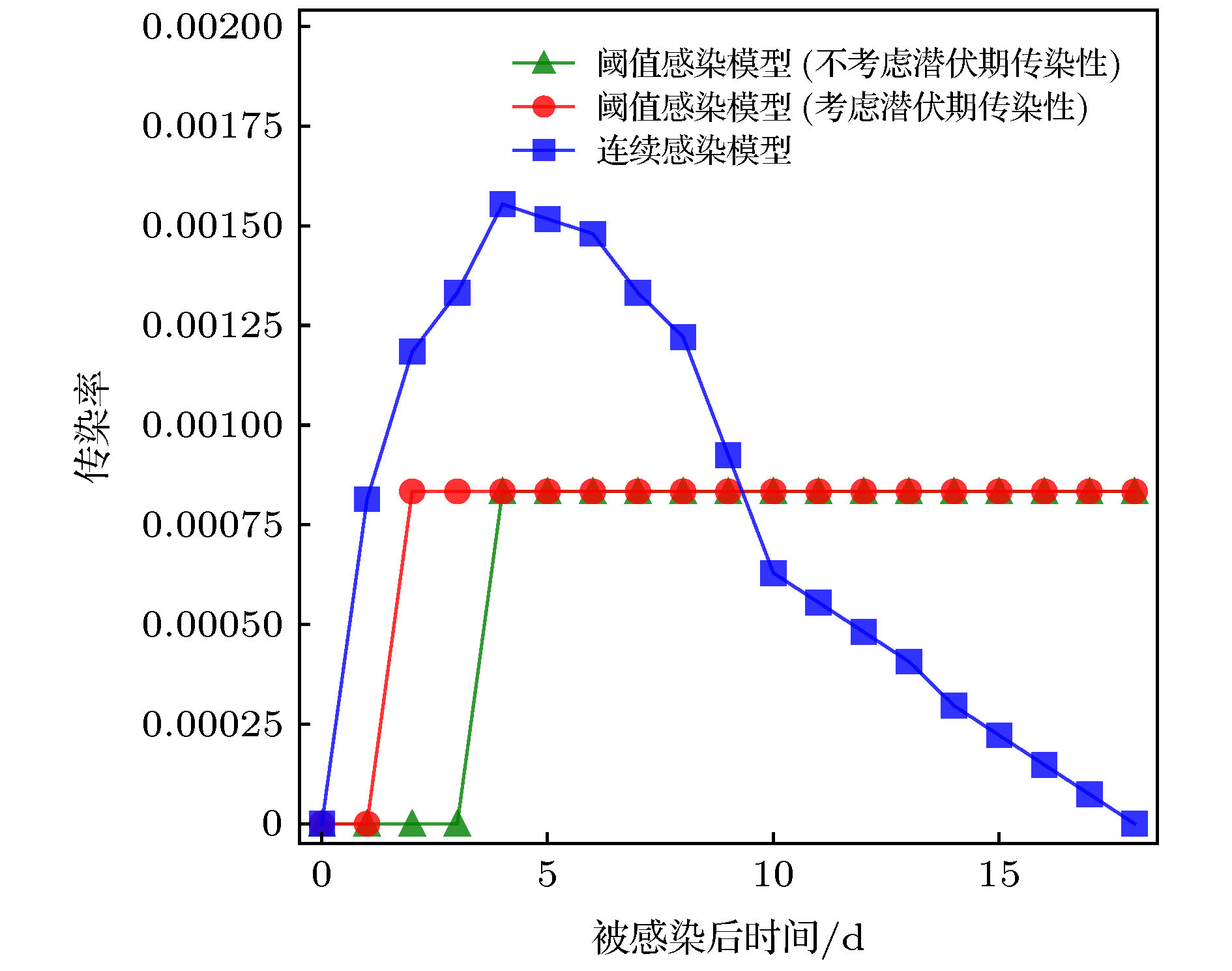
 下载:
下载:
